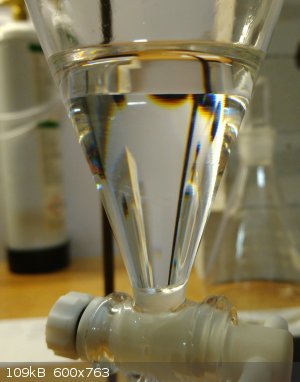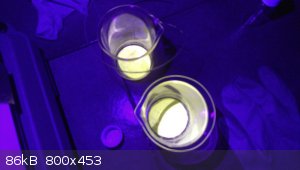
beta4 - 31-12-2019 at 07:02
Hi,
I'm trying to make some pyridine from niacin, using basic copper carbonate as catalyst. However, the liquid I collected, when treated with sodium
hydroxide separates into three layers, which to my knowledge is not supposed to happen.
I've watched NileRed, Doug's lab and Extractions & ire videos, as well as following this procedure:
https://www.sciencemadness.org/talk/viewthread.php?tid=20145...
The first part of the reaction went smooth, 50g of niacin and 12g of basic copper carbonate were mixed and added to a distillation apparatus. 30.8mL
of yellow distillate were slowly collected, weighing 29.1g. I maybe continued distilling a bit too far to try collecting every possible drop.
1.5g of NaOH was added to the crude distillate, and a second distillation was performed to purify the product. However, I started collecting the first
drops with the still head at just 93°C, while pyridine should boil at 115.2°C.
Temperature varied significantly during the distillation, peaking at 95°C, then lowering to 85°C, then peaking again at 91°C and finally lowering
as no more distillate came over. 26.3mL of crystal clear distillate were collected, weighing 25.0g.
I thought that my pyridine simply had a lot of water in it, as there is a pyridine-water azeotrope at 92.6°C, composed of 57% pyridine. So I added 3g
of NaOH to the distillate, with the intention of adding a lot more. However, even after an hour of stirring, the NaOH did not fully dissolve, which
looked strange considering how much water was supposed to be there.
When I decanted the solution in a separatory funnel three layers separated. The bottom opaque layer is likely the water / NaOH layer, the middle layer
is (hopefully) my pyridine, but the top layer is ... what?

The starting niacin is lab grade, so it's supposed to be pure. The copper carbonate may have been contaminated with K2SO4 as I made it from copper
sulfate and potassium carbonate, but I don't think it could make a difference. The ground glass joints were sealed with some teflon tape, could
pyridine have reacted with teflon?
[Edited on 31-12-2019 by beta4]
beta4 - 31-12-2019 at 10:36
The middle layer turned out to be pyridine, indeed. I put it back in the distillation apparatus with some NaOH. It distilled all between 110 and
111°C leaving no residue, just dry NaOH. My thermometer is nothing special, just an alcohol thermometer, an I never calibrated it, so I'll call that
close enough to pyridine's boiling point.
The top layer (which is less than it looks, due to the perspective when the photo was taken) is quite oily and most of it stuck to the side walls of
the separatory funnel when draining the middle layer. I didn't bother recovering it. Still no idea what it was, though.
draculic acid69 - 3-1-2020 at 01:07
Calibrate your thermometer.mine reads 108'c when in boiling water.
beta4 - 8-1-2020 at 16:02
I've calibrated my thermometer in boiling water. It reads between 93 and 94°C, and this brings my previous measurements within a couple of degrees
from pyridine's boiling point.
In the end I collected ~23mL, weighing 21.8g, so also the density is close to theoretical, and the final yield is 68%, which is good too.
The oily third layer remains a mystery though, considering that this reaction has been done by so many other chemists both here and on youtube, and no
one reported a third layer.
beta4 - 26-5-2020 at 14:40
I'll add some notes here even though it's been a few months since my last post.
I thought that to really check if what I made was pyridine, making the fluorescent complex described by woelen was a good idea.
https://woelen.homescience.net/science/chem/exps/fluorescent...
I first tried making it with copper iodide made through this process
https://www.sciencemadness.org/whisper/viewthread.php?tid=15...
and it didn't work.
However, when I tried making again the copper iodide using woelen's method (using sodium sulfite) it did work.

Although it's not officially a qualitative test for pyridine, it's good enough for me to be reasonably sure that the synthesis was successful.
That, and now I have a nice fluorescent compound.
G-Coupled - 26-5-2020 at 18:13
Very cool - I'm glad you achieved success. 

